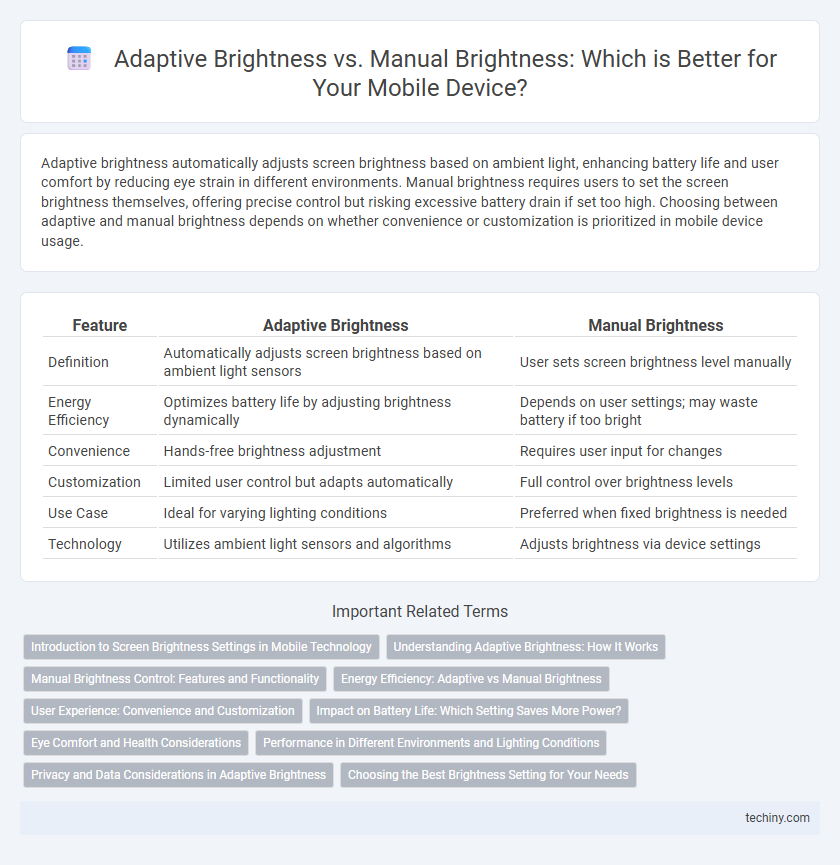Adaptive brightness automatically adjusts screen brightness based on ambient light, enhancing battery life and user comfort by reducing eye strain in different environments. Manual brightness requires users to set the screen brightness themselves, offering precise control but risking excessive battery drain if set too high. Choosing between adaptive and manual brightness depends on whether convenience or customization is prioritized in mobile device usage.
Table of Comparison
| Feature | Adaptive Brightness | Manual Brightness |
|---|---|---|
| Definition | Automatically adjusts screen brightness based on ambient light sensors | User sets screen brightness level manually |
| Energy Efficiency | Optimizes battery life by adjusting brightness dynamically | Depends on user settings; may waste battery if too bright |
| Convenience | Hands-free brightness adjustment | Requires user input for changes |
| Customization | Limited user control but adapts automatically | Full control over brightness levels |
| Use Case | Ideal for varying lighting conditions | Preferred when fixed brightness is needed |
| Technology | Utilizes ambient light sensors and algorithms | Adjusts brightness via device settings |
Introduction to Screen Brightness Settings in Mobile Technology
Screen brightness settings in mobile technology significantly impact device usability and battery life. Adaptive brightness automatically adjusts the screen's luminance based on ambient light sensors, enhancing user comfort and conserving energy. Manual brightness requires user input to set a fixed level, providing control but potentially leading to inefficient battery usage or eye strain in changing lighting conditions.
Understanding Adaptive Brightness: How It Works
Adaptive brightness technology uses ambient light sensors to automatically adjust the screen's luminance for optimal visibility and battery efficiency. By analyzing real-time lighting conditions, it dynamically modifies brightness levels to reduce eye strain and conserve power. This smart adjustment contrasts with manual brightness settings, offering a more intuitive and energy-saving user experience on smartphones and tablets.
Manual Brightness Control: Features and Functionality
Manual brightness control allows users to set screen brightness levels according to personal preference or environmental conditions, offering precise customization not influenced by ambient light sensors. This feature is essential for conserving battery life on mobile devices by enabling lower brightness settings when full luminance is unnecessary. Users can quickly adjust brightness through device settings or quick access menus, enhancing usability in various lighting environments.
Energy Efficiency: Adaptive vs Manual Brightness
Adaptive brightness uses ambient light sensors to automatically adjust screen luminosity, optimizing energy consumption by reducing brightness in darker environments. Manual brightness requires user intervention, often leading to higher energy usage due to consistently elevated brightness levels. Studies show adaptive brightness can extend battery life by up to 20% compared to manual settings, enhancing overall mobile energy efficiency.
User Experience: Convenience and Customization
Adaptive brightness enhances user experience by automatically adjusting screen luminance based on ambient light, reducing eye strain and conserving battery life without manual intervention. Manual brightness control offers users precise customization, allowing them to set display levels tailored to personal preference in varying environments. Combining both methods can optimize convenience and customization, ensuring a seamless visual experience across diverse lighting conditions.
Impact on Battery Life: Which Setting Saves More Power?
Adaptive brightness automatically adjusts screen luminance based on ambient light sensors, optimizing visibility while conserving battery by reducing excessive brightness. Manual brightness settings often lead to higher power consumption when users set brightness levels too high or forget to lower them in darker environments. Studies show that adaptive brightness can extend battery life by up to 15%, making it a more energy-efficient choice for mobile devices.
Eye Comfort and Health Considerations
Adaptive brightness technology automatically adjusts screen luminance based on ambient light, reducing eye strain by maintaining optimal visibility without excessive brightness. Manual brightness control allows personalized screen settings but risks prolonged exposure to harsh lighting conditions, potentially causing eye fatigue and discomfort. Prioritizing adaptive brightness can support better eye comfort and help mitigate health issues related to digital eye strain.
Performance in Different Environments and Lighting Conditions
Adaptive brightness utilizes ambient light sensors to dynamically adjust screen brightness, optimizing visibility and conserving battery life in varying environments. Manual brightness offers consistent control but may lead to suboptimal performance in rapidly changing lighting conditions, requiring frequent user adjustments. Devices equipped with adaptive brightness generally deliver better performance and user comfort across diverse lighting scenarios compared to static manual settings.
Privacy and Data Considerations in Adaptive Brightness
Adaptive brightness technology relies on sensors and algorithms to adjust screen luminosity automatically, which may collect ambient light data and usage patterns, raising potential privacy concerns. Unlike manual brightness control, adaptive systems often gather and process contextual information continuously, increasing the risk of data exposure or misuse if privacy safeguards are inadequate. Users concerned about data privacy should evaluate device permissions and opt for manual brightness settings to minimize sensor data sharing.
Choosing the Best Brightness Setting for Your Needs
Adaptive brightness automatically adjusts screen brightness based on ambient lighting using sensors, enhancing battery life and reducing eye strain in varying environments. Manual brightness allows precise control, ideal for users needing consistent display settings or when automatic adjustments are inaccurate. Selecting the best brightness setting depends on individual preferences, usage patterns, and device sensor effectiveness.
Adaptive Brightness vs Manual Brightness Infographic

 techiny.com
techiny.com